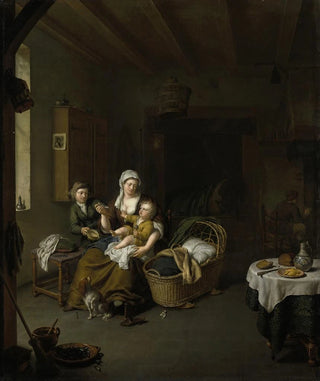Art print | A mother feeds her child - Willem van Mieris


View from behind

Frame (optional)
In the rich and complex universe of 17th-century Dutch painting, "A Mother Nourishing Her Child" by Willem van Mieris stands out for its gentle intimacy and emotive portrayal of motherhood. This artwork, imbued with tenderness, invites the viewer to immerse themselves in a moment of everyday life, where simplicity of gestures blends with palpable emotional depth. The scene depicts a caring and affectionate mother feeding her child, a tableau that evokes both the beauty of maternal bonds and the delicacy of shared moments. In this art print, every detail is carefully reproduced, allowing you to feel the warmth and closeness emanating from this interaction.
Style and uniqueness of the artwork
Willem van Mieris's style is characterized by finesse and meticulous attention to detail. In "A Mother Nourishing Her Child," the chosen color palette is soft and soothing, creating an atmosphere of serenity. The subtle play of light, orchestrated with skill, highlights the textures of the clothing and the expressions of the characters. The composition is balanced, with each element having its place in this intimate tableau. The mother's posture, slightly leaning toward her child, as well as the tender gaze she directs at him, are elements that reinforce the scene's emotion. Van Mieris excels in capturing moments of life, and this work is a perfect illustration, blending realism and sensitivity.
The artist and his influence
Willem van Mieris, born in 1662 in Leiden, established himself as one of the masters of Dutch painting of his time. Son of the artist Frans van Mieris, he was trained in a stimulating artistic environment, which undoubtedly influenced his style. His career, marked by prolific output, includes portraits, genre scenes, and still lifes. Van Mieris drew inspiration from great masters such as Rembrandt and Vermeer, while developing a personal signature that is uniquely his own. His influence is evident in the way he approaches themes of everyday life, highlighting moments of tenderness and intimacy.

Matte finish

View from behind

Frame (optional)
In the rich and complex universe of 17th-century Dutch painting, "A Mother Nourishing Her Child" by Willem van Mieris stands out for its gentle intimacy and emotive portrayal of motherhood. This artwork, imbued with tenderness, invites the viewer to immerse themselves in a moment of everyday life, where simplicity of gestures blends with palpable emotional depth. The scene depicts a caring and affectionate mother feeding her child, a tableau that evokes both the beauty of maternal bonds and the delicacy of shared moments. In this art print, every detail is carefully reproduced, allowing you to feel the warmth and closeness emanating from this interaction.
Style and uniqueness of the artwork
Willem van Mieris's style is characterized by finesse and meticulous attention to detail. In "A Mother Nourishing Her Child," the chosen color palette is soft and soothing, creating an atmosphere of serenity. The subtle play of light, orchestrated with skill, highlights the textures of the clothing and the expressions of the characters. The composition is balanced, with each element having its place in this intimate tableau. The mother's posture, slightly leaning toward her child, as well as the tender gaze she directs at him, are elements that reinforce the scene's emotion. Van Mieris excels in capturing moments of life, and this work is a perfect illustration, blending realism and sensitivity.
The artist and his influence
Willem van Mieris, born in 1662 in Leiden, established himself as one of the masters of Dutch painting of his time. Son of the artist Frans van Mieris, he was trained in a stimulating artistic environment, which undoubtedly influenced his style. His career, marked by prolific output, includes portraits, genre scenes, and still lifes. Van Mieris drew inspiration from great masters such as Rembrandt and Vermeer, while developing a personal signature that is uniquely his own. His influence is evident in the way he approaches themes of everyday life, highlighting moments of tenderness and intimacy.






